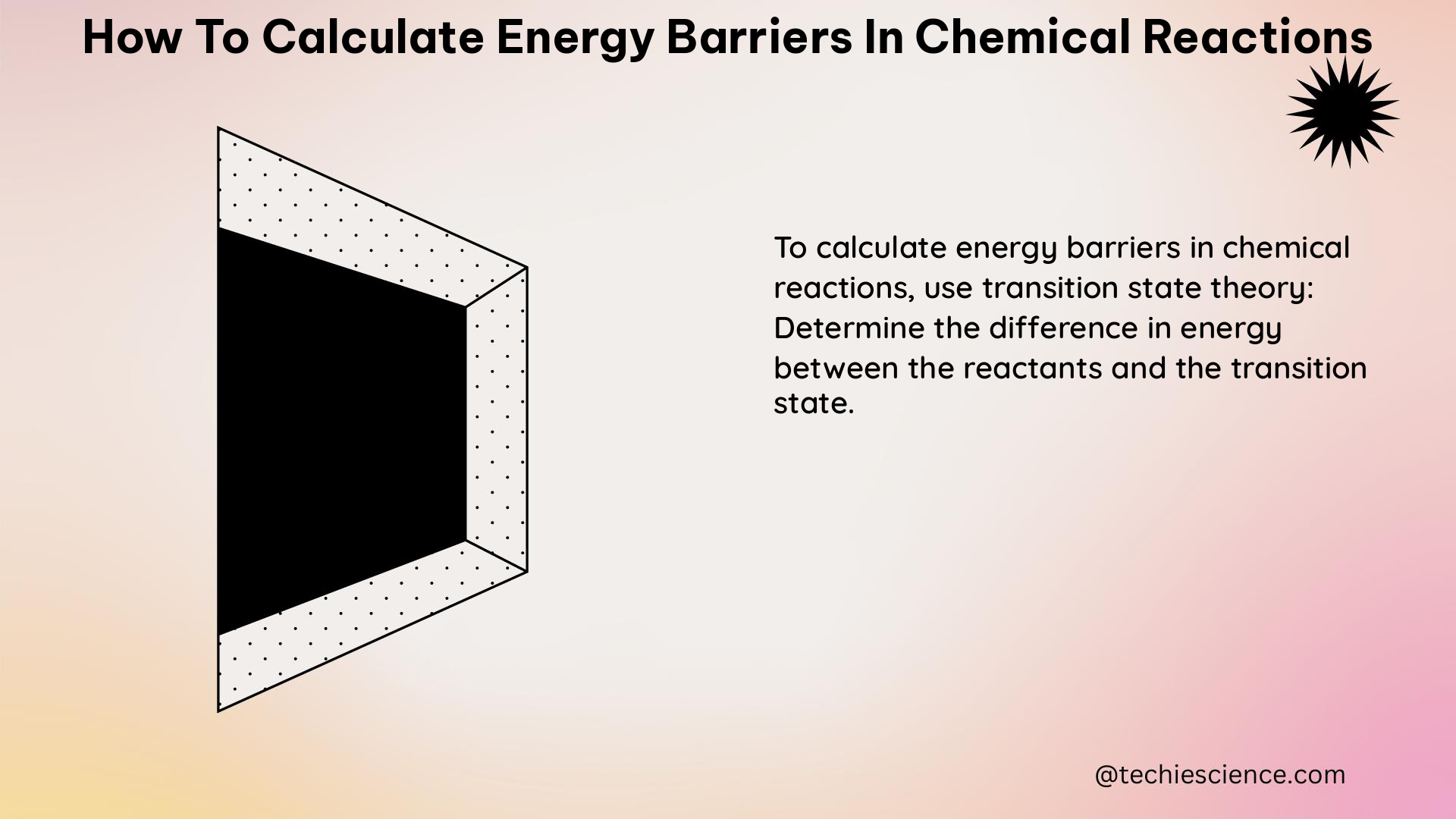Calculating energy barriers in chemical reactions is a crucial step in understanding the kinetics and thermodynamics of chemical processes. This comprehensive guide will provide you with a detailed, step-by-step approach to calculating energy barriers, including the necessary theoretical background, practical considerations, and real-world examples.
Calculating the Energy Barrier
1. Transition State (TS) and Reactant Geometries
The first step in calculating the energy barrier is to determine the geometries of the reactant and transition state. This can be done using computational chemistry methods, such as Density Functional Theory (DFT) or higher-level methods like Coupled Cluster Singles Doubles with perturbative Triples (CCSD(T)).
Procedure:
1. Optimize the geometry of the reactant using DFT or CCSD(T) calculations.
2. Locate the transition state (TS) geometry using methods like the Synchronous Transit-Guided Quasi-Newton (STQN) approach or the Nudged Elastic Band (NEB) method.
3. Verify the transition state by ensuring that it has a single imaginary frequency corresponding to the reaction coordinate.
2. Electronic Energy
Once the geometries of the reactant and transition state are known, the next step is to calculate their electronic energies ((E_{el})). This can also be done using DFT or CCSD(T) methods.
Procedure:
1. Calculate the electronic energy of the reactant ((E_{el, reactant})) using DFT or CCSD(T).
2. Calculate the electronic energy of the transition state ((E_{el, TS})) using the same level of theory.
3. Vibrational Corrections
Vibrational contributions to the energy barrier must be taken into account to obtain accurate results. This can be done by calculating the vibrational corrections ((\Delta E_{vib})) using DFT methods.
Procedure:
1. Perform a vibrational frequency analysis on the optimized reactant and transition state geometries.
2. Calculate the zero-point energy (ZPE) and thermal corrections to the electronic energy for both the reactant and transition state.
3. Obtain the vibrational corrections as the difference between the reactant and transition state vibrational contributions.
4. Solvation Effects
If the reaction occurs in a solvent, the solvation energy ((\Delta G_{solv})) must be included in the energy barrier calculation. This can be done using implicit solvation models, such as the Polarizable Continuum Model (PCM) or the Solvation Model based on Density (SMD).
Procedure:
1. Calculate the solvation energy of the reactant ((\Delta G_{solv, reactant})) using a solvation model like PCM or SMD.
2. Calculate the solvation energy of the transition state ((\Delta G_{solv, TS})) using the same solvation model.
5. Free Energy of Activation
The final step is to calculate the free energy of activation ((\Delta G^{\ddagger})), which represents the energy barrier for the reaction. This is done by combining the electronic energy, vibrational corrections, and solvation effects.
Equation:
[\Delta G^{\ddagger} = G^o_{TS} – G^o_{reactant} = E_{el, TS} + \Delta E_{vib, TS} + \Delta G_{solv, TS} – (E_{el, reactant} + \Delta E_{vib, reactant} + \Delta G_{solv, reactant})]
Example Calculations

Here are some example calculations of energy barriers for the cyanide (CN) addition reaction using different computational methods:
| Compound | B3LYP | CCSD(T) | Exp. |
|---|---|---|---|
| 2 CN | 9.90 | 14.71 | 17.7 |
| 3 CN | 10.69 | 12.73 | 16.2 |
| 4 CN | 10.31 | 9.48 | 13.6 |
These results show that the CCSD(T) method generally provides better agreement with experimental data compared to the B3LYP DFT method, highlighting the importance of using high-level computational methods for accurate energy barrier calculations.
Factors Affecting Energy Barriers
Several factors can influence the energy barrier of a chemical reaction, including:
1. Bond Strengths
The strength of the bonds that need to be broken or formed during the reaction can affect the energy barrier. For example, the bond strengths of metal-carbonyl (M-CO) bonds are Cr: 27 kcal/mol, Mo: 32 kcal/mol, and W: 33 kcal/mol.
2. Molecular Geometry
The geometry of the reactants and transition state can influence the energy barrier. For instance, the orientation of reactants during a collision can affect the likelihood of a successful reaction.
3. Temperature
Temperature affects the kinetic energy of molecules, which in turn affects the fraction of molecules with enough energy to overcome the activation barrier. A 10°C increase in temperature generally doubles the rate of a chemical reaction.
Theoretical Background
Thermodynamics
The energy barrier is related to the Gibbs free energy of activation ((\Delta G^{\ddagger})), which is a thermodynamic property. (\Delta G^{\ddagger}) can be broken down into enthalpy ((\Delta H)) and entropy ((\Delta S)) components:
[\Delta G = \Delta H – T \Delta S]
Kinetics
The rate of a chemical reaction depends on the energy barrier. The higher the energy barrier, the slower the reaction, and vice versa. This relationship is described by the Arrhenius equation:
[k = A e^{-\frac{\Delta G^{\ddagger}}{RT}}]
where (k) is the rate constant, (A) is the pre-exponential factor, (R) is the universal gas constant, and (T) is the absolute temperature.
References
- ORCA tutorials. (n.d.). Calculating accurate energy barriers. Retrieved from https://www.orcasoftware.de/tutorials_orca/react/actibar.html
- ACS Central Science. (2023). The Intrinsic Barrier Width and Its Role in Chemical Reactivity. Retrieved from https://pubs.acs.org/doi/10.1021/acscentsci.3c00926
- Bradley R. Hacker. (n.d.). Thermodynamics Notes. Retrieved from https://hacker.faculty.geol.ucsb.edu/geo124T/lecture.html
- Chemistry LibreTexts. (2023). Energetics of Chemical Reactions. Retrieved from https://chem.libretexts.org/Bookshelves/Introductory_Chemistry/Introduction_to_General_Chemistry_%28Malik%29/04:_Stoichiometry_the_quantification_of_chemical_reactions/4.06:_Energetics_of_chemical_reactions
- Chemistry LibreTexts. (2022). Activation Barriers. Retrieved from https://chem.libretexts.org/Bookshelves/General_Chemistry/Book:_Structure_and_Reactivity_in_Organic_Biological_and_Inorganic_Chemistry_%28Schaller%29/IV:__Reactivity_in_Organic_Biological_and_Inorganic_Chemistry_2/01:_Reaction_Kinetics/1.03:_Activation_Barriers

The lambdageeks.com Core SME Team is a group of experienced subject matter experts from diverse scientific and technical fields including Physics, Chemistry, Technology,Electronics & Electrical Engineering, Automotive, Mechanical Engineering. Our team collaborates to create high-quality, well-researched articles on a wide range of science and technology topics for the lambdageeks.com website.
All Our Senior SME are having more than 7 Years of experience in the respective fields . They are either Working Industry Professionals or assocaited With different Universities. Refer Our Authors Page to get to know About our Core SMEs.